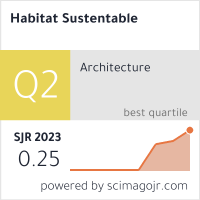Factibilidad de aprovechamiento de la energía solar e impactos previsibles de las nuevas reformas del código urbano y de edificación: Propuestas para la ciudad de Mendoza, Argentina
Palabras clave:
Desarrollo urbano sustentable, morfología urbana, potencial solarResumen
El objetivo del trabajo es generar conocimientos que permitan realizar propuestas conducentes a una mayor sostenibilidad energético-ambiental de los sistemas urbanos regionales, en función de sus características morfológicas y del recurso solar disponible. En una primera etapa se ha realizado un análisis de las zonas de alta densidad edilicia a partir de los resultados de indicadores relevantes y su análisis estadístico. Los indicadores expresan relaciones entre morfología urbana y acceso al recurso solar en el Área Metropolitana de Mendoza (AMM), e incluyen: Factor de Asoleamiento Efectivo (FAE) y el Factor de Asoleamiento Volumétrico (FAV). Los resultados del análisis estadístico han permitido evaluar las correlaciones de cada variable morfológica sobre cada indicador, según distintas alternativas morfológicas y combinaciones de las mismas, lo que constituye la parte sustancial de este trabajo. En una segunda etapa se presentan los resultados parciales de un estudio que tiene como objetivo determinar los impactos energéticos ambientales de las recientes reformas del Código Urbano y de Edificación de la ciudad en estudio, en función del FAV y estimar la reducción del acceso al recurso solar respecto a la situación de referencia (actual, sin cambios) y situación futura, en una ciudad con el carácter único de Mendoza como “ciudad-oasis”. Los resultados obtenidos hasta el momento indican que la reducción de la energía solar disponible por unidad de volumen construido sería sustancial: 46,32% para muros al norte y 60,38% techos.
Descargas
Descargas
Publicado
Cómo citar
Número
Sección
Licencia
El contenido de los artículos que se publican en cada número de Hábitat Sustentable, es responsabilidad exclusiva de los autores y no representan necesariamente el pensamiento ni comprometen la opinión de la Universidad del Bío-Bío.
Los autores/as conservarán sus derechos de autor y garantizarán a la revista el derecho de primera publicación de su obra, el cuál estará simultáneamente sujeto a la Licencia de Reconocimiento de Creative Commons CC BY-SA que permite a otros compartir-copiar, transformar o crear nuevo material a partir de esta obra con fines no comerciales, siempre y cuando se reconozcan la autoría y la primera publicación en esta revista, y sus nuevas creaciones estén bajo una licencia con los mismos términos.











 Programa de Información Científica/Concurso Fondos de Publicación de Revistas Científicas 2018/ Proyecto Mejoramiento de Visibilidad de Revistas UBB (Código:FP180007)
Programa de Información Científica/Concurso Fondos de Publicación de Revistas Científicas 2018/ Proyecto Mejoramiento de Visibilidad de Revistas UBB (Código:FP180007) 





